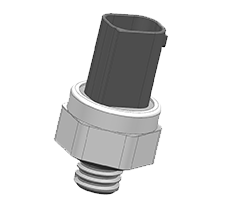

The product is designed based on Hall principle, and is installed on the chassis of the car. It is a sensor used to read the wheel speed.
Hermetically sealed, magnetically operated non-contact sensing gives excellent life and reliability
Robust construction makes this sensor well suited to harsh environments
High Accuracy
According to customer requirements, a variety of ranges can be customized
The working temperature range is - 40-150 ℃
Two Hall chips are installed inside, which can realize redundancy function
The automobile wheel speed sensor is a subsystem of ABS/ESP, which is used to detect the follow-up signal of wheel speed, convert it into an electrical signal through the Hall effect, and transmit it to the ECU. The ECU judges the speed according to the change characteristics of the electrical signal, so as to regulate the timely work of ABS/ESP.
Hall type wheel speed sensor uses the principle of Hall effect, that is, control current is applied at both ends of the semiconductor sheet, and a magnetic field with a magnetic field strength of B is applied in the vertical direction of the sheet, then an electric potential whose size is proportional to the product of control current and magnetic induction strength B will be generated at the other ends of the sheet, which is called Hall potential.
When Hall element is used as the wheel speed sensor of an automobile, magnetic induction intensity B is usually used as the input signal. When magnetic induction intensity B changes with wheel speed, Hall potential pulse is generated. After amplification, shaping and power amplifier inside Hall integrated circuit, pulse sequence is output outward, and its duty cycle changes with the angular speed of the turntable. The rotation of the gear disc alters the magnetoresistance, causing the change of magnetic induction intensity, which can measure the Hall potential pulse output by the sensor.
Customized to customer choice of connection system.
Custom packaging can be provided to meet any need, please contact KESENS Engineering for details.











